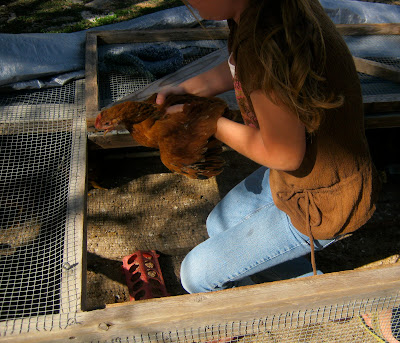Last year I wrote about our first venture into raising meat
chickens (read about it here). My daughter was grossed out ('70s expression!). Our
chicken farmer friend refused to eat any of his flock, disgusted after watching
them grow. Nonetheless, we decided to try again, using lessons learned.
This experience was more pleasant, albeit with one disturbing
development.
First, we resolved never to raise Cornish Rocks again. They
were bred for size, and as their size increased their brain size diminished. At
least, that’s our theory. This time we ordered Red broilers, another type of
meat chicken. The most important factor in this decision: they are not white so the poop on their
feathers would be camouflaged.
We took delivery of 25 chicks in October, ensuring they
would reach maturity in the winter. The last batch suffered terribly in the
heat of last May. They finally got so large they couldn’t move – and couldn’t reach water.
 |
| Moving Day! |
This breed is much more appealing. When grown, the chickens were
quite pretty. They did not get as large as the white ones, and so were able to
move around freely. These were Einsteins compared to the last batch: these
chickens knew how to scratch and find the pen at night.
The disgust factor was much lower this
time around. Don't discount the importance of this.
 |
| Bandy and one of his lay-dies. |
However, we had another problem. Our rooster, Bandy
Bojangles, matured into a full-grown rooster at about the time the meat
roosters did. He and a younger rooster, his son L’il, took to bullying the meat
roosters. By processing time, Bandy had killed at least two, injured another,
and forced us to send L’il to our neighbor’s chicken farm for his own
protection. Bandy, the Godfather of Gitmo.
Due in part to the carnage of the mob wars, we ended up with around
20 birds to dress.
Our middle son helped with the processing of the first
batch. I fully intended to help this time, as he was not available. However,
once my husband began the unpleasant part (involving the innards – let’s say no
more), he gave me a pass. He was afraid I would not be able to eat chicken
afterwards. “Well, if you’re sure, honey,” I said, as I edged away from the
kitchen. This has damaged my standing as a Pioneer Woman, but I think I can
live with that.
So what do we think about home-grown chicken? It is tougher
than store-bought meat. We plan to try brining one soon, to see if that tenderizes
it. I cannot tell a taste
difference, but Dan says it tastes a little stronger to him, a little wilder than
store-bought. (He has a more discerning palate in these matters.) These chickens have much larger drumsticks and smaller breasts
– both of which suit our dining style.
Yes, we will continue raising our own meat chickens. Though we may
have to bump off the Godfather. Rub
him out. He might end up sleeping with the fishes. But don’t tell him I said
so. I’m a little afraid of him.
Favorite spot in the garden:
My favorite spot is right outside my window right now. Part of its charm is the movement of the Lindheimer's muhly (Muhlenbergia lindheimeri), so I've taken a movie to share instead of a static photo.
In case that doesn't work, which is entirely possible, here is that static photo:
Favorite spot in the garden:
My favorite spot is right outside my window right now. Part of its charm is the movement of the Lindheimer's muhly (Muhlenbergia lindheimeri), so I've taken a movie to share instead of a static photo.
In case that doesn't work, which is entirely possible, here is that static photo:










